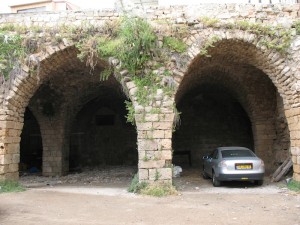[vc_row margin_bottom=”50″][vc_column][vc_column_text el_class=”mb-md”]
A Brief History of Garages
[/vc_column_text][vc_column_text]

America takes garages for granted. They come standard with most houses now. You put your car in them, you put your unwanted materials in them, or you have some other use for them. Garages are just standard practice.
That wasn’t always the case. Especially for garage doors. At some point, someone came along and had to invent the concept of a separate room where you would store your transportation. It’s a weird, crazy thought, but where exactly did garages and garage doors come from?[/vc_column_text][/vc_column][/vc_row][vc_row type=”2″ padding_top=”50″ padding_bottom=”50″][vc_column][vc_column_text]According to historical sources, there is evidence of garages as early as 3500 B.C. It was none other than Homer himself, in The Odyssey, which described rooms similar to garages. Instead of putting the latest car in them, they would store chariots in these rooms, which would then be used later. This makes sense, as chariot racing was the NASCAR of its time.
Prior to the 20th century, these buildings were known primarily as “carriage houses” or “gatehouses.” Whatever they were called, they were an important backbone to society. In some instances, there were entire cities that were dedicated to storing chariots and other modes of transportation. Jerusalem was one such city, which was utilized as a storage place for chariots during times of peace.
Eventually, chariots were phased out, and in came the horse and buggy days. Carriage houses would be the place where both were stored. As the years progressed, carriage houses became more and more ornate, as well as a more and more integral part of society.[/vc_column_text][/vc_column][/vc_row][vc_row type=”3″ padding_top=”50″ padding_bottom=”50″][vc_column][vc_column_text]The carriage house was also looked as as a status symbol in society. Because it was a separate room that stored a horse and buggy, that means you needed money in order to construct this. Construction was a much more difficult task to accomplish prior to the Industrial Revolution, which means that only the most elite could possess a carriage house.
As society became more and more industrialized, so to did construction and transportation. Much like the chariots of old, so too did the horse and buggy get put our to pasture. In its stead was the motorized carriage, or the car, which took up residence in the old carriage houses.
[/vc_column_text][/vc_column][/vc_row][vc_row margin_top=”50″ margin_bottom=”50″][vc_column][vc_column_text]The carriage house itself got outdated. Older carriage houses required a lot of space to store not only the buggy, but the horses. This required much more space and materials than the compact car. That’s when the carriage house began getting smaller and smaller. Eventually, they became one room shelters, or “garages.”
Cars became far more commonplace than any of the other modes of transportation that needed storage. This is one of the reasons that mechanized garage door openers were needed. Overhead Door founder C.G. Johnson is widely attributed as the inventor of the electric garage door opener in 1926. From there, he was able to found the Overhead Door company.
Today, Hill Country Overhead Door carries on the legacy of Johnson and all of the people before that used garages, carriage houses, and gatehouses. While the methods might have changed over the year, our dedication to garage door repair San Antonio style remains the same.[/vc_column_text][/vc_column][/vc_row][vc_row type=”1″ padding_top=”50″ padding_bottom=”50″][vc_column][vc_column_text]Sources:
1. https://visual.ly/history-garage
2. https://www.amazines.com/article_detail.cfm/4014144?articleid=4014144
3. https://www.overheaddoor.com/Pages/company-history.aspx
4. https://www.naturalhandyman.com/iip/infgar/infgar1h.html[/vc_column_text][/vc_column][/vc_row]
